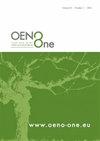气候变化对法国葡萄酒产区葡萄种植的影响
IF 2.2
3区 农林科学
Q3 FOOD SCIENCE & TECHNOLOGY
引用次数: 0
摘要
气候变化是法国葡萄酒行业面临的主要挑战。法国葡萄园的气候条件已经发生了变化,并将继续影响葡萄栽培。本研究旨在通过物候模拟,分析法国葡萄酒产区农业生态气候指标的演变。利用SAFRAN气候数据对近过去期(1962-1991年至1992-2021年)和未来预估期(1985-2014年至2041-2070年)的这种演变进行了分析,预估期采用两个SSP轨迹(SSP2-4.5和SSP5-8.5)。采用了19个CMIP6气候模式和3个物候模式以及1个水平衡模式。物候模型参数和训练系统特征适应各区域,尽可能与当前实践相匹配。自20世纪下半叶以来,生长季节的温度已上升了+1°C至+2.1°C,到2070年,地中海周围地区的温度可能上升到+3.7°C。降水的模式间差异较大,仅法国西部地区(海洋性气候)在2040-2071年的SSP5轨迹上观测到葡萄生长季降水的显著变化(减少)。所有模拟物候阶段都向更早的日期偏移。到2070年,它们的出现应该会更早,法国东部黑皮诺中期的平均提前22天。理论成熟日(含糖量)也应根据所考虑的地区和SSP从19天提前到30天。在21世纪下半叶早期,接近光合作用最佳状态的热条件将促进植物的生长。在果实发育期间,高温天数和葡萄水分亏缺的增加会影响所有葡萄酒产区的葡萄产量和质量。春季霜冻预估显示,与目前的情况相比,21世纪下半叶的风险没有显著变化。本文章由计算机程序翻译,如有差异,请以英文原文为准。
Projected impacts of climate change on viticulture over French wine regions using downscaled CMIP6 multi-model data
Climate change is a major challenge for the French wine industry. Climatic conditions in French vineyards have already changed and will continue to evolve impacting viticulture.This study aims to analyse the evolution of agro- and eco-climatic indices based on phenology simulation of French wine-growing regions. This evolution was analysed on a recent-past period (1962–1991 to 1992–2021) using SAFRAN climate data and on a future projected period (1985–2014 to 2041–2070) with two SSP trajectories (SSP2-4.5 and SSP5-8.5). A set of 19 CMIP6 climate models downscaled at 8 km grid resolution over France coupled with three phenological and a water balance model were used. Phenological model parameters and training system characteristics were adapted to each region to match as much as possible current practices.Temperatures during the growing season have increased by +1 °C to +2.1 °C since the second half of the 20th century and could rise to +3.7 °C in regions around the Mediterranean by 2070. The inter-model variance concerning the precipitation is high, a significant change (decrease) in precipitation during the grapevine growing season is observed only for the regions of western France (Oceanic climate) over the period 2040–2071 with the SSP5 trajectory. All simulated phenological stages have shifted toward earlier dates. Their occurrence should be even earlier by 2070 with an average advance of up to 22 days for the mid-veraison of Pinot noir in eastern France. The theoretical maturity date (sugar content) should also be advanced from 19 to 30 days depending on the considered region and SSP. Thermal conditions closer to the photosynthetic optimum should promote onset by the early second half of the 21st century. The increase in both the number of hot days and grapevine water deficit during the period of fruit development should impact grape production in quality and quantity in all wine-growing regions. Spring frost projections show no significant change in risk for the second half of the 21st century, compared to current conditions.
求助全文
通过发布文献求助,成功后即可免费获取论文全文。
去求助
来源期刊

OENO One
Agricultural and Biological Sciences-Food Science
CiteScore
4.40
自引率
13.80%
发文量
85
审稿时长
13 weeks
期刊介绍:
OENO One is a peer-reviewed journal that publishes original research, reviews, mini-reviews, short communications, perspectives and spotlights in the areas of viticulture, grapevine physiology, genomics and genetics, oenology, winemaking technology and processes, wine chemistry and quality, analytical chemistry, microbiology, sensory and consumer sciences, safety and health. OENO One belongs to the International Viticulture and Enology Society - IVES, an academic association dedicated to viticulture and enology.
 求助内容:
求助内容: 应助结果提醒方式:
应助结果提醒方式:


